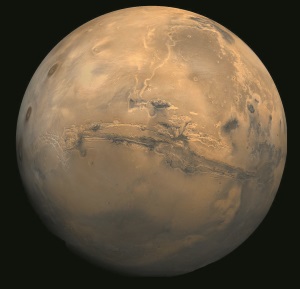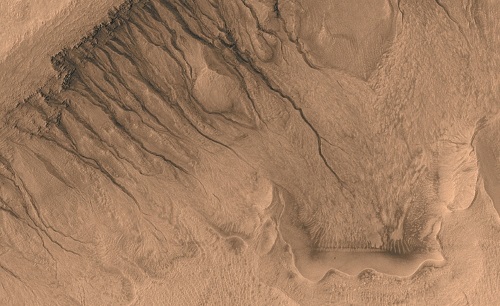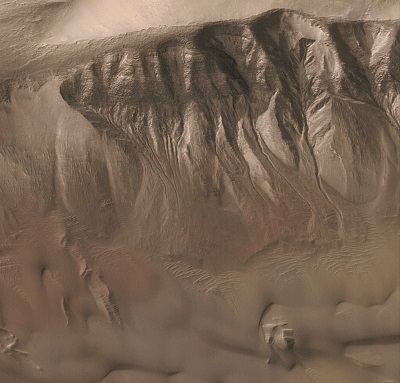Mission to Mars
The search for meaning

Among the most prominent features on the Martian surface is the massive canyon formation known as the Valles Marineris. The canyon system is more than 4,000 km (2,486 miles) long, 200 km (125 miles) wide, and up to 7 km (5 miles) deep. Compare this with Earth’s Grand Canyon at 446 km (277 miles) long, 30 km (18 miles) wide, and 1.6 km (1 mile) deep. Click for larger view.
For nearly two centuries, the planet Mars has captured the imagination of Earth-bound astronomers. The Red Planet displays intriguing features and ever-changing conditions, which have lead to claims that life and flowing water once existed on its surface.
In the late 19th century, American astronomer Percival Lowell became the most ardent supporter of claims for intelligent life on Mars. He was inspired by reports from Italian scientist Giovanni Schiaparelli of long, straight lines criss-crossing the surface.1 Lowell claimed the existence of an advanced alien civilization was without doubt.2
But by the 1950s, it was clear that the Martian atmosphere was too thin to support most, if not all, forms of life. There are dangerous levels of ultraviolet radiation striking the surface of the planet and a complete absence of oxygen in the atmosphere. This made it almost impossible to conceive of any form of advanced life existing there.
Missions to Mars
However, in June this year [2003], three new missions to the Red Planet were launched. At the heart of these missions is the search for extraterrestrial life.3
The first mission to launch, the European Space Agency’s (ESA’s) Mars Express, lifted off on 3 June, carrying the Beagle 2 landing craft.4 Even the name of this probe suggests the evolutionary overtones of the mission. The ESA craft carries the name of the ship on which evolutionist Charles Darwin sailed as a naturalist in 1831–36. While on board the original Beagle, Darwin began to develop his theory of evolution by means of natural selection.5
Not far behind Mars Express are NASA’s twin Spirit and Opportunity Mars rovers, each launched separately and heading for different parts of the Martian surface.6
ESA and NASA’s decision to launch their probes in 2003 was made due to Mars’ impending opposition, the point at which Earth lies directly between the sun and Mars, at which point Mars will be at its closest approach to Earth. This year’s opposition is special because, in evolutionary timescales, Mars has not been this close in more than 60,000 years (see Mars at its closest for 60,000 years?).


Beagle 2 is set to touch down on the planet’s surface on Christmas day this year, while Spirit and Opportunity are due to land in early 2004. While all three craft are being sent to different parts of Mars, they all have a similar objective: to find evidence of water on the Martian surface.
Evidence for water
As far as long-range observations of Mars’s surface go, little direct evidence has been found for water. The polar ice caps, the most likely source of water, are mostly composed of carbon dioxide.
Any water ice that comes into contact with the thin and dry Martian atmosphere would quickly change from solid into gas in a process known as sublimation.
But most scientists are sure that liquid water played a part in shaping Mars’ surface. In 2001, images captured by the orbiting spacecraft Mars Odyssey, show geographical features that look like lakes, riverbeds and flood plains.4
That’s why the landing zones of each of the three craft have been specially selected to prove that liquid water once flowed on Mars. NASA’s Spirit rover will touch down in a massive impact crater known as Gusev Crater, Opportunity will land in an area rich in hematite (a form of iron oxide) known as Meridiani Planum, and Beagle 2 will land in a large flat basin known as Isidis Planitia.4
The Gusev landing zone, chosen by NASA, lies at the end of a massive 900-kilometre (600-mile)-long channel called Ma’adin Vallis, which many scientists believe was once an ancient riverbed.
If this is correct, then the Gusev Crater could have acted as a giant lake into which water once flowed.4
NASA’s second landing site, Meridiani Planum, is another good candidate for evidence of water.
From space, the area appears to show sedimentary layers. This suggests it may have been flooded in the past, with water-borne sediments being deposited as floodwaters receded. There is also an abundance of crystalline hematite, a mineral known to form in iron-rich water, which seems to further the scientists’ position.4
The ESA scientists have chosen a landing site ignored by their NASA counterparts. The large flat basin of Isidis Planitia contains small volcanic cones, similar to those formed on Earth when superheated magma comes into contact with liquid water.4
Other explanations
On the surface, these scientists seem to have compelling evidence for the existence of liquid water in the planet’s distant past. However, things are not always as they first appear.
In the same New Scientist article in which the above information was reported, there are also three, just as compelling, arguments against the landing zones’ providing the sought-after prize of watery relics!


The Gusev Crater/Ma’adin Vallis formation, landing zone of the Spirit rover, is not the only one of its kind in the solar system. Similar formations exist on the waterless surface of the moon, where astronomers have named them sinuous rilles. While scientists are not certain how sinuous rilles form, possibly as a result of lava flows, they are sure they are not formed by water.4
The Opportunity site at Meridiani Planum also presents alternatives. The sedimentary layers seen at the site could be the result of repeated (or even individual) volcanic eruptions forming layers of ash (as seen at Mount St. Helens on Earth).7Furthermore, crystalline hematite is also known to form by oxidation, when iron-rich lava flows to the Earth’s surface,4 and is consistent with a volcanic origin.
Finally, Isidis’ volcanic cones could be explained by an explosive reaction created when carbon dioxide ice (like that at the Martian poles) came into contact with molten lava, once again without liquid water ever being present.
Does water mean life?
It is possible that hard evidence for liquid water may be found on Mars. There is an underlying evolutionary assumption that where there is water, life also exists, which demonstrates the true motivation behind the current missions.
In the popular science journal Astronomy, freelance science writer William Speed Weed observes: ‘Life as we understand it does not exist without water. That’s worth taking a moment to contemplate, and, perhaps, worship’8 [emphasis added].
That is why the search for water on Mars has taken on a religious significance. If, as the scientists reason, we can find liquid water in extraterrestrial environments, then we should also be able to find life.
And the search for liquid water has not stopped with Mars. Astronomers are taking their assumptions about the evolution of life on Earth and applying them to other possible solar systems.
Water, just one part of the equation
Science has proven that life cannot form spontaneously, water or no water. Lifeless chemicals do not, and cannot, form themselves into living, reproducing organisms.9 Even if liquid water is found to have existed on Mars or anywhere else in the universe, it is one, and only one, of a number of stringent requirements for life.10
Our planet, Earth, lies in a particularly providential place for life to exist. Its orbit lies within what astronomers call the ‘habitable zone’. This narrow zone, just the right distance from the sun, is neither too hot nor too cold for liquid water to exist.

Earth also has an atmosphere that provides enough pressure for liquid water to exist and protects the surface from harmful radiation. The position of the moon in its orbit around the Earth is also significant. If the moon were any closer, the tidal forces would be massive, causing continental flooding at every high tide. If the moon were further away, its tidal influence would be too small, allowing marine environments to stagnate, resulting in the death of all marine life.11
Astronomers searching for planets in other solar systems are keen to find Earth-like candidates. That’s because small rocky planets at just the right distance from their star are prime candidates for liquid water to exist, for without liquid water, the evolution of life would be impossible.12 But no matter where they have looked to date, they have found nothing.
Yet even if Earth-like planets are found, as we have seen, it takes more than just the possibility of liquid water to sustain life.
Water in space

Expect a big splash
If one of these three missions finds evidence for water on Mars (and there is a chance they will) expect a big splash in the media. We are likely to be told the water proves that life came to Earth from Mars. Such a claim would not only go far beyond the evidence found, but fly in the face of all observed scientific facts. Science has proved that life cannot form spontaneously from lifeless chemicals. Even the simplest reproducing organism is so incredibly complex that it could not have assembled itself from chemicals by chance.
To Christians, the existence of water elsewhere in space should not come as a surprise. Water was present from the beginning (Genesis 1:1) and some creationist scientists believe it played an important role in God’s creation of the universe13 (see also 2 Peter 3:5). However, its presence in liquid, solid or gaseous form, despite what evolutionists would have us believe, gives no support to the theory that life evolved on Earth or elsewhere in the universe.
Rather, the Bible clearly tells us how life arose. God created the different kinds of life over a period of four days, starting with plant life on Day 3 of Creation Week and ending with the pinnacle of creation, humans, on Day 6. The existence of liquid water on Earth, and all the other finely tuned circumstances making life possible, point towards the provision of a loving Creator, not the random acts of chance evolution.
Meaning of life
Underpinning the search for water and life in outer space is the search for meaning. A humanity that has rejected the Word of God and the real history of the universe contained in the Bible will continue to seek answers in all the wrong places. But the Bible, and in particular the book of origins, Genesis, does provide answers to the hard questions.
Mankind has looked for life in outer space for centuries, but to this day has not found any. In all likelihood the current Mars missions, while exciting in many respects, will also prove futile in this area. (However, it’s not beyond the realm of possibility that microscopic bacterial life could have been transported there by Earth ejecta in the past.) For us, our greatest insights lie not in placing our faith in the fallible speculations of man but rather in the Word of a faithful God. It is through His Word that God has revealed both the history and the future of the universe, and provided a way for us to have a life with true purpose and meaning.
References and notes
- Ridpath, I. and Tirion, W., Mars; in: Stars and Planets, 3rd edition, Collins, London, pp. 348–350, 2000. Return to text.
- Schiaparelli called the lines he saw on Mars canali, which is Italian for ‘channels’. This was mistranslated into the English as ‘canals’, on which Lowell based his claims of extraterrestrial origins for the strange features he saw on Mars. Return to text.
- Race on to unlock Mars mysteries, The West Australian newspaper, Perth, Australia, Saturday, 14 June 2003, p. 40. Return to text.
- Mullins, J., New Scientist 178(2396):29–31, 24 May 2003. Return to text.
- Lavallee, L., Acts and Facts 32(4):4, April 2003. Return to text.
- NASA’s ‘Spirit’ rises on its way to Mars, mars.jpl.nasa.gov, 30 June 2003. Return to text.
- Ham, K., ‘I got excited at Mount St Helens!’, Creation 15(3):14–19, June 1993. Return to text.
- Weed, W.S., Astronomy 29(8):43, 2001. Return to text.
- See Q&A: Origin of Life. Return to text.
- Ham, K. and Batten, D., Is There Intelligent Life in Outer Space? Answers in Genesis, Brisbane, Australia, 2002. Return to text.
- DeYoung, D., Astronomy and the Bible, 2nd edition, Baker Books, Michigan, USA, 2000. Return to text.
- Naeye, R., Astronomy 30(11):53, 2002. Return to text.
- Humphreys, D.R., Starlight and Time: Solving the Puzzle of Distant Starlight in a Young Universe, Master Books, Arizona, 2000. Return to text.















Readers’ comments
Comments are automatically closed 14 days after publication.